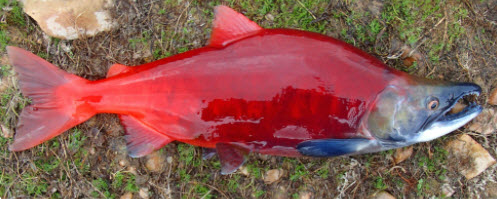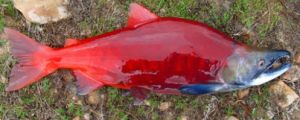Lost at sea: ‘Business in Vancouver’ (BIV) has reported that global Pacific salmon numbers dropped sharply during 2020. Global abundance of Pacific salmon in 2020 was the lowest it has been since 1982 according to the North Pacific Anadromous Fish Commission (NPAFC). Russia’s commercial catch dropped from 600,000 tonnes to 400,000 and officials there are so worried that they have convened an emergency meeting of fisheries’ scientists.
Dick Beamish from the Pacific Biological Station in Nanaimo has called what happened in 2020 as an ‘international Pacific salmon emergency’. Brian Riddell, from the Pacific Salmon Foundation said that he did not think that there was any question that what is happening in recent years is an ocean impact affect linked to climate change. Daniel Pauly, from the Institute of Oceans and Fisheries agrees’ highlighting that candlefish, another anadromous species, is exhibiting similar declines to salmon, especially in its southern range. He added that what is happening is a global trend that is happening to salmon that mirrors everything else that is happening in the world, especially nearer to the equator.
Alaska’s Bristol Bay is one of the few fisheries bucking the trend but even Alaska is not unaffected – as will be discussed later. The British Columbian catch in 2019 and 2020 is the lowest in history and these poor catches extend north up into Alaska. The total abundance of sockeye in the Fraser River were the lowest in 2019 and 2020.
Dick Beamish says that there is growing scientific evidence that the problem is not so much that there are not enough fish returning to spawn and then the young making it to the ocean but rather the young fish are failing to thrive and grow fast enough after they enter coastal waters due to a lack of food. He added that increased hatchery production may do little to offset the decline. He believes that changing climate has resulted in reduced capacity in the coastal ocean to support the growth of many salmon smolts.
None of this news is really surprising, but what is, is the complete silence from self-professed salmon expert Alexandra Morton. She claims that salmon declines in the Fraser River are due to the presence of salmon farms, and she has persuaded the First Nation people to support her claims. This might be appealing from a local perspective, but the reality is that salmon from the Fraser River are part of a global population that are suffering a real emergency.
As in Scotland, the reality is that the salmon farming critics are doing more harm to the future of wild salmon by deflecting attention away from the real issues affecting global salmon populations. In Scotland, salmon farming has minimal impact on wild fish stocks, but the critics are unable to open their eyes to the fundamental issues affecting fish stocks. After nearly thirty years of criticising salmon farming, it is extremely hard for the critics to admit that they may be wrong.
All at sea: A new scientific report in Nature redefines the oceanic distribution of Atlantic salmon. The researchers tagged over two hundred kelts (salmon that have spawned) from seven European areas and maiden North American salmon captured at sea around Greenland and found that fish migrated further north and east than previously reported. The fish also displayed increased diving activity near oceanic fronts highlighting the importance of these regions as feeding areas. The location of these fronts is influenced by climate induced changes.
The link to this research was retweeted by the Tay Salmon Fishery Board who posed a relevant question – where is the Scottish contribution to this work? The list of researchers includes people from Norway, England, Ireland, Denmark, Iceland, the USA, and Spain, yet there was no input from Scotland, despite the widespread distribution of salmon in Scottish rivers.
I have often heard that the focus on salmon in Scotland should be targeted at those areas where a difference to safeguarding salmon’s future can be made. Thus, the emphasis has been placed on what happens to salmon within rivers and in the coastal areas of the sea and most especially on salmon farming because the wild fish sector think that this is the easiest threat to control. Of course, this is a blinkered short-sighted view and clearly as marine mortality has probably the greatest impact on salmon’s future, marine research should be a priority, especially when it is collaborative with every other nation. Instead, this new research has been severely comprised because of Scotland’s absence. It seems that it is not just the salmon, but also the researchers who are all out at sea.
Big Bang: Alaska’s Cordova Times reported at the beginning of June that the Copper River salmon fishery for sockeyes and Chinooks has been closed due to the low number of fish passing through the counter. At the time, the count was the 13th lowest on record between 1978 and 2021 and according to the Alaska Department of Fish and Game, it was the fourth lowest number in the last 50 years.
The newspaper has said that a lot of speculation has been forthcoming as too why the Copper River sockeyes and Chinooks have been so troubled in recent years. In addition to the usual causes such as climate change, many fishermen have been pondering about the possible role military exercises in the Gulf of Alaska have played in the reduced number of fish passing through the counter.
There has been a lot of speculation about the impact these military exercises have on salmon migrating out of the river system, especially the effect of all the munitions that end up in Gulf have on young salmon.
The comments in the Cordova Times about the military exercises piqued my interest. This is because I have been aware of the possibility that munitions have also had an impact on Scottish west coast stocks of wild fish. This is not because of military exercises, although the UK’s nuclear submarine fleet do pass through the area, but what I would like to consider here is a totally different proposition.
Some time ago, there was a discussion about building a bridge from Scotland to Northern Ireland and one of the challenges raised was the presence of Beaufort’s Dyke.
Beaufort’s Dyke is a natural trench between Northern Ireland and Scotland within the North Channel. The dyke is 50 km long, 3.5 km wide and 200–300 m deep. However, it was not the physical nature of the dyke that was the problem, but rather that Beaufort’s Dyke was the United Kingdom’s largest offshore dump site for surplus conventional and chemical munitions after the Second World War, although it had been used for this purpose since the Great War. The Ministry of Defence estimate that well over a million tonnes of munitions have been dumped there. This includes some 14,500 tonnes of 5-inch artillery rockets filled with phosgene that were dumped there in July 1945.
It is known that small sized munitions such as hand grenades regularly wash up on beaches on both sides of the North Channel, but what is unknown is how the munitions are breaking down over time releasing all types of potentially toxic chemicals. With the general flow of the currents heading north, these chemicals are possibly being dispersed all along Scotland’s west coast.
Marine Scotland Science have developed a list of threats to wild salmon and sea trout, but of course no consideration is ever given to the potential damage caused by the long-term breakdown of these munitions. The wild fish sector was recently paid by Marine Scotland Science to plot the various threats to wild fish, but they are all too focused on others such as salmon farming to even include chemical contamination on the list of potential threats. They have probably not given the risk to wild fish from these dumped munitions even one moment’s thought.


